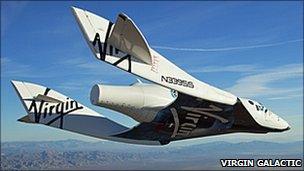Virgin Galactic's spaceship makes solo flight
- Published
Virgin has released footage of the VSS Enterprise taking its first flight
Virgin Galactic's suborbital spaceship, Enterprise, has made its first solo test flight, in California.
The spaceship was carried to an altitude of 45,000ft (13,700m) by an aeroplane and then dropped to glide back to the Mojave Air and Space Port.
Enterprise will soon be taking people prepared to pay $200,000 (£126,000) on short hops above the atmosphere.
The British billionaire behind the project, Sir Richard Branson, was on hand to witness the drop test.
"This was one of the most exciting days in the whole history of Virgin," the entrepreneur said.
"For the first time since we seriously began the project in 2004, I watched the world's first manned commercial spaceship landing on the runway at Mojave Air and Space Port and it was a great moment."
Virgin Galactic is aiming to become the world's first commercial space line, and has already taken deposits from 370 customers who want to experience a few minutes of weightlessness on a suborbital flight.
"We're not far off booking out our first year of operations," said Stephen Attenborough, head of astronaut relations at Galactic.

Enterprise will soon start rocket motor testing
"We'll see exactly how many we decide to fly in year one, but the intention has always been around 500. We're well on our way to that," he told BBC News.
The Enterprise ship is based on the X-Prize-winning SpaceShipOne vehicle, which made history in 2004 by successfully flying to 100km (60 miles) in altitude twice in a two-week period.
The new ship, built by Mojave's Scaled Composites company, is bigger and will be capable of carrying eight people - two crew and six passengers.
When it eventually enters service, Enterprise will be carried to its launch altitude by the "Eve" carrier plane before being released in mid-air. Enterprise will then ignite its single hybrid rocket engine to make the ascent to space.
Although Eve and Enterprise have made several test flights together, Sunday was the first time the spaceplane had been released at altitude.
Two pilots were at the controls, Pete Siebold and Mike Alsbury. They guided the ship back to the Mojave runway.
The entire flight took about 25 minutes. On later test flights, Enterprise will fire its rocket engine.
Only when engineers are satisfied all systems are functioning properly will passengers be allowed to climb aboard.
"We are focused on safety and making sure we know everything about this vehicle before we put it into commercial operations. There is a timetable in terms of what we're going to do, but as we've said many times before, 'it takes as long as it takes', Mr Attenborough said.
"The next big milestone will be when we start the rocket motor propulsion tests."
- Published2 October 2010